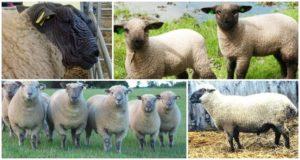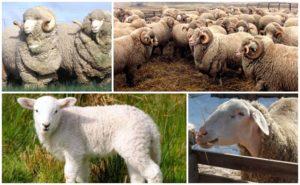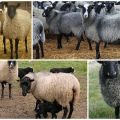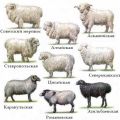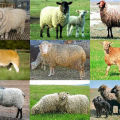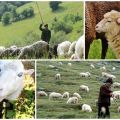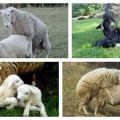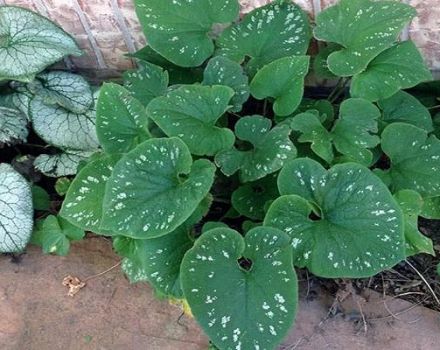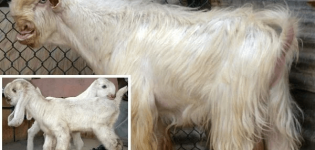Description and characteristics of the Kalmyk sheep breed, maintenance rules
For hundreds of years, the Kalmyk breed of fat-tailed sheep has occupied an honorable place in the list of the most productive animals. High-quality cheeses are produced from the milk of obese beauties, and tender meat and fat tail fat of lambs have long been recognized by lovers of delicious food. Due to its rare simplicity, keeping pets is within the power of even a beginner.
History of the breed
The history of the appearance of Kalmyk sheep in Russia dates back to the 17th century. These years were marked by the exodus of nomads from the territories of the western part of China and Mongolia. Under the leadership of Khan Ho-Orlyuk, the Kalmyks moved to the vastness of Russia.
Nomadic peoples have long been engaged in cattle breeding. Thanks to the Spartan winter conditions, free access to the best pastures and constant movement, the animals had endurance and strong immunity.
Despite the political upheavals in the history of the country, the peoples lived together peacefully on the same territory. Kalmykia was rightfully ranked first in the livestock industry. However, after the end of the Second World War, the Kalmyk autonomy was disbanded, and people were resettled to the lands of the Astrakhan region and Kazakhstan.
New neighbors appreciated the productive qualities of Kalmyk sheep, so they began to actively cross their curly pets with the animals that had arrived. As a result of simple manipulations, 2 more unique breeds of fat-tailed sheep were born - Edilbaevskaya and Gissar.

Main characteristics and description of the Kalmyk sheep
Knowing the main characteristics and description of the Kalmyk sheep, it is difficult to confuse a pet with representatives of other breeds. Sheep are endowed with pronounced distinctive features:
- Pets have truly grenadier growth. The growth of rams often exceeds 80 cm. Females are somewhat smaller.
- The weight of the animals is consistent with the height. The mass of an adult ram ranges from 100 to 145 kg. The weight of an ewe depends on the season and ranges between 55-90 kg. Young pets gain weight gradually. Until the age of 1.5 years, sheep fatten up a weight equal to 45-50 kg.
- Graceful, dry legs confidently hold the voluminous body of a lamb. This combination gives the animal an unusual, graceful appearance. The limbs are set correctly, without defects. The pet's hind legs are protected by a layer of fat.
- The powerful, sturdy lamb body resembles a perfect cylinder.Well-developed muscles and an even straight back of the animal are complemented by a wide sacrum. The chest is deep.
- The head of the curly handsome man is small, neat. The pet's profile is decorated with a barely noticeable hump. Bulging cheeks and long, drooping ears give the animal a special charm.
- Most pets are hornless, only 15% of animals have small horns.
- Kalmyk sheep are known for their thick, coarse wool. Due to its coarse structure, wool of Kalmyk sheep is less valued than products obtained from pets of other breeds. No more than 5% of high-quality raw materials are obtained from one sheep of the Kalmyk breed. Grade 2 wool accounts for 25% of the total weight. The remaining 70% of wool is classified into category 3.
- The most common sheep are red and golden-beige. In some areas, white lambs predominate, with black markings on the head and legs. The most appreciated are individuals of pure white color.
- The pet's tail resembles an elastic pillow. Here is the fatty sac, generously filled with fat. The dimensions of the natural container are 14-25 cm in height and 12-21 cm in width. The size of the fat tail directly depends on the degree of fatness of the handsome man. Depending on the planting of a fatty bag on the body of a sheep, farmers distinguish several types of fat tail: low, medium and high. In Kalmyk lambs, fat is located not only in the tail area. The nutrient layer covers the hind limbs of the animal, starting from the lumbar zone and ending with the pet's lower hocks. The total mass of fat tail fat for each ram is 15-17 kg. To a greater extent, the stock is fed by walukh lambs. For pedigree producers, the indicators are slightly more modest. Females produce more internal fat.
Pros and cons
The choice of breed for breeding depends on the personal preference of the farmer and the availability of beneficial qualities in the animal. Given the pros and cons of the breed, you can count on the profitability of the farm.
Positive traits:
- Strong immunity reliably protects pets from numerous ailments.
- Endurance. This quality went to sheep from legendary ancestors.
- High rates of weight gain in pets. The weight of an adult ram easily overcomes the 100 kg bar. The lamb's weight and size differ from birth. The weight of a newborn lamb is 5 kg.
- Productivity. Sheep serve as a reliable supplier of lard, meat, milk and wool. The fat tail fat obtained from Kalmyk sheep is a champion in taste and useful properties. The product is softer than internal fat and melts at a temperature of 40 degrees.
- Environmental friendliness. Walking on free grazing, pets are scattered over the territory. In search of food, sheep eat only the upper leaves of plants. Thus, the pasture is not trampled and the vegetation remains intact.
Disadvantages:
- Mediocre quality of pet hair.
- Significant deterioration in the taste and quality of meat as the sheep mature.
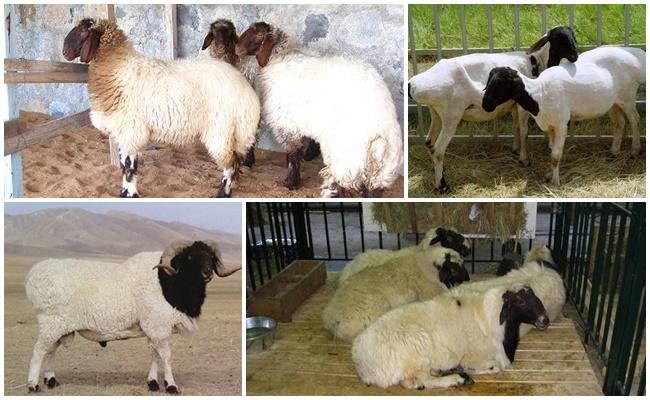
Requirements for maintenance and care
A typical farm building is suitable for keeping pets. Koshara is insulated, not forgetting about the artificial or natural ventilation system. In the cold season, the optimal room temperature is from +7 to +10 degrees. Separate compartments are provided for pregnant women and ewes who have recently given birth. Here, the air temperature is maintained in the range from +17 to +20 degrees. Sheep do well in a dry, draft-free environment.
Pets are unpretentious, therefore, the requirements for maintenance and care are as follows:
- Annual inspection.
- Routine vaccinations.
- Hoof trimming (2 times a year).
- Bathing (2-3 times during the warm season).
- Haircut (2 times, in spring and autumn).
How and what to feed?
In the summertime, animals make do with pasture. A large mass of juicy grass provides the lambs with the necessary substances.
In winter, the daily ration of pets consists of 2 kg of fragrant hay, 700 g of special canned food and 1 kg of juicy, nutritious food.
Reproduction
Experienced breeders mate in the last weeks of autumn. The lions reach maturity by 8-10 months and are ready for reproduction from that moment. The interval between periods of heat is 15-16 days. The duration of the favorable period for mating is 48 hours. A sheep bears offspring for 145 days. Usually the female brings 2-3 babies annually. In most cases, lambing passes without complications. The newborn lamb is cleaned of traces of mucus, but is not separated from the mother.
Within a couple of hours after birth, the baby begins to walk confidently. After 2 days, the lamb joins the herd. For 6 weeks, the calf feeds only on breast milk. During this period, the pet daily gains 500 g in weight. After 1.5 months, the lamb is accustomed to adult food.
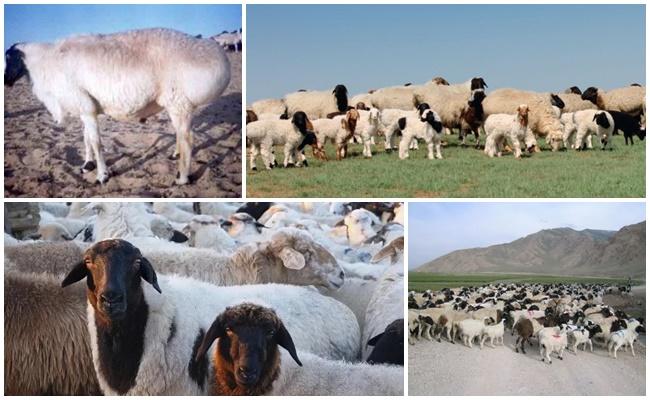
The active lactation period lasts 4 months. Sheep are reluctant to be milked. The animals try to keep the milk, therefore, during the procedure, the lambs are allowed closer to the mother. The fat content of evening milk is 10%, morning milk - 9.5%.
Breeding area
Sheep farms are successfully operating in the Republic of Kalmykia and Kazakhstan. Sometimes fat-tailed sheep can be seen on the farms of the North Caucasus.
Diseases and methods of their treatment
In rare cases, Kalmyk sheep are affected by:
- Cystitis. The disease begins with an infection of the udder. As a rule, the disease leads to inflammation of the bladder. The sick animal is transferred to light feed. Antibiotic injections and drinking plenty of fluids can help cope with the disease.
- Stomatitis. Sheep suffers from oral inflammation. The affected areas are treated with hydrogen peroxide. Sheep feed is given in a liquid or slimy consistency.
- Tympania of the scar. The disease is expressed in severe swelling of the digestive tract of the pet. Stopping the scar can kill the sheep. The drug "Tympanol" is administered to the animal with the help of a rubber tube.



